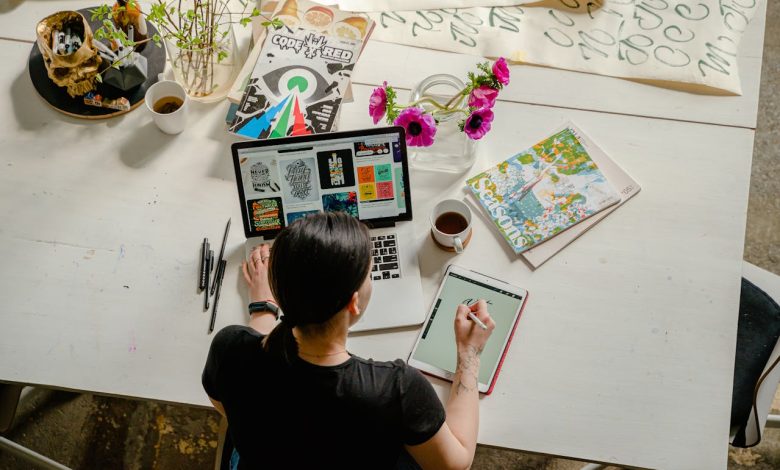How to be a Graphic Designer Without a degree

Fortunately, in the creative world of graphic design, all that matters is creativity and skill. Despite all of that, you can be a successful graphic designer without the degree. Until a couple years ago, becoming a self-taught designer was largely undisciplined and piecemeal, but with the uptick in online resources, tutorials, and practical applications to learn from you can build an impressive career as a UX/UI designer without attending a traditional classroom.
Interested in design and yet do not have the paper to prove it, you can follow this simple guide on how to be a Graphic Designer.
1. To Know The Basics of Graphic Design
Before we get into design tools and projects, it is important that you know the basic ideas of graphic form. These are the principles that every great design is built on, and they will direct your creative choices.
Fundamentals Design Elements: ColorTypographyLayoutShapesSpace Understanding how these pieces fit together creates compositions that have balance and appeal visually.
If you have already studied these, read them again because design principles are something that require practice and experience. Based on these principles, they will help you convey your message efficiently in an aesthetic way.
Layout & Composition: Learn how to compose your designs, how to present information and the use of grids in order for your layout to be harmonious.
This is more than enough for getting the basics and there are loads of free resources to get started, like Canva Design School, TutsPlus or Smashing Magazine.
2. Acquire knowledge of the Industry-Standard Tools
Becoming proficient in design software is part of becoming a graphic designer. Here are top tools currently used in the industry:
Adobe Creative Cloud — Photoshop (for image editing), Illustrator (for vector graphics), InDesign (for layout design) — Adobe’s suite of design tools is the de facto resource for most graphic design jobs. Except, they do not come free but you pay for subscription that offers some extensive power and flexibility.
Free or Affordable Alternatives: There are some free or paid alternatives to Adobe software (no yearly fees), such as GIMP (like Photoshop), Inkscape (alternative for Illustrator) and Affinity Designer (a one-time purchase vector and raster graphic design tool).
Canva is for beginners: Canva can help you with very little creativity to create designs using the pre-made templates and it has an easy environment to design your thoughts. And Figma is a popular tool for UI/UX design it’s free if used by individual user.
Learn these tools by watching online tutorials on YouTube, Skillshare or platforms like Udemy — where you can even go back to your examples and try yourself, because nothing beats practice.
3. Start Developing a Powerful Portfolio Now
In the world of graphic design, your portfolio is everything and a resume means very little. Both employers and potential clients want to know what you’re capable of, and a well elevated portfolio can often showcase the breadth of your skills.
Personal Projects First: If you do not have any paid design work yet, start with personal projects. You can remake the logos of different companies, make social media graphics, or even create posters and flyers for products that do not exist. The trick is to demonstrate a range of design talents.
Freelance Work : You can have small freelance jobs via Upwork, Fiverr or 99designs. You can also reach out to friends, family or local businesses and offer to design materials for them in order to get real experience from the top-down and build your portfolio.
What’s your workflow: One of the things I loooove of seen in portfolios, is when you showcase what your process was (Not just show the final material). Share your process behind the design, the problems you faced and how did you overcome those. This shows prospective clients or employers how you think and solve problems.
4. Study Design Trends and Learn from others
Good graphic design comes out of a place that ever changes and so it is important to keep up with latter-day trends. Looking at design blogs, social media accounts and websites like behance / dribble and even pinterest can provide daily inspiration as well help you keep up to date with what is going on in and around the world of design.
Learn Successful Designers: Find the most effective designs and understand why are they as good as you think. Each work of them may provide you the good insight in understanding their usage of color, typographic and compositional choices. By absorbing the wisdom of designers I have their years, ahead at a much faster pace.
Design trends: In recognizing the importance of developing your own style, being aware of current design trends will keep you competitive. Color palettes, typography styles and minimalism trends are always changing and if you adapt your work to the latest trends it will not be out-dated as soon.
5. Practice your skill
Like every other skill, the only way to get better at design is practice. Graphic design is a creative discipline and,as with any other, it takes hours of diligence to become a master. Try working on a variety of different projects featuring varying styles — the more diversity you create for yourself, the wider your range will become.
Partcipate in design challenges: Join a challenge, or start following daily prompts to test your speed and creativity. Sites like Daily UI or DesignCrowd host frequent challenges for you to keep in shape and show off your work.
Modify Design: Pick designs from existing websites, apps or companies and reapply it with your own feast. This forces you to use what you know but also practice your invention and creativity.
Get Feedback: Start sharing your work with other designers and get some feedback Share your work and others into web/online design communities such as the Reddit subreddit for graphic design called r/graphic_design, or on DesignLab in order to receive constructive criticism and become a better professional.
6. Online Classes And Certificates
You may no longer be in school, but there are online courses designed to enhance your design knowledge and build skills. Some courses provider certificates indicating the success of completing a course, which can give your reputation a boost.
Both Skillshare, Coursera, and Udemy offer an extensive selection of classes related to graphic design that span from introductory to advanced. You will learn about UX/UI design, branding, principles of design, software etc.
Specialization: Second step (after learning the foundations of graphic designing), is to specialize in an area of interest, like logo design or web design or even packaging. Some of those relevant skills can make you more desirable to hiring people or clients.
7. Network and Build Connections
Relationships amongst the design community is crucial to tapping opportunities and growing your career. You can do networking without a degree and it can bring you jobs, freelance projects or even collaborations.
Meetups and Conferences: Just some related to design or web, it could be a follow-up workshop near you or even in another country. Use places like Meetup or Eventbrite to find design events happening near you.
Join Online Communities: There are many online communities like Behance or Dribbble and LinkedIn groups to communicate with other designers, showcasing your work and getting notified of job openings.
If you want an opportunity to experience something new, you might consider collaborating with other creatives like web developers, photographers or marketers.
8. Apply for Jobs and Internships
After you have some work in your folio and confidence in your abilities, take those graphic design jobs or internships you deserve. Bay Area experience goes a long way with many companies and school name recognition is less important than your portfolio and personal projects.
Create Your Application: If you are applying for a full-time job, customize your resume, portfolio and cover letter each time. Spin your skills, software knowledge and best work on it’s head.
Final Thoughts
With the correct balance of passion, practice, and perseverence it is entirely possible to become a graphic designer without degree! Learn the fundamentals of web design, practice with design applications, and create a body of work you can show off to potential clients. Thanks to the countless resources and communities online, you can carve your own way to a fulfilling future in graphic design.



